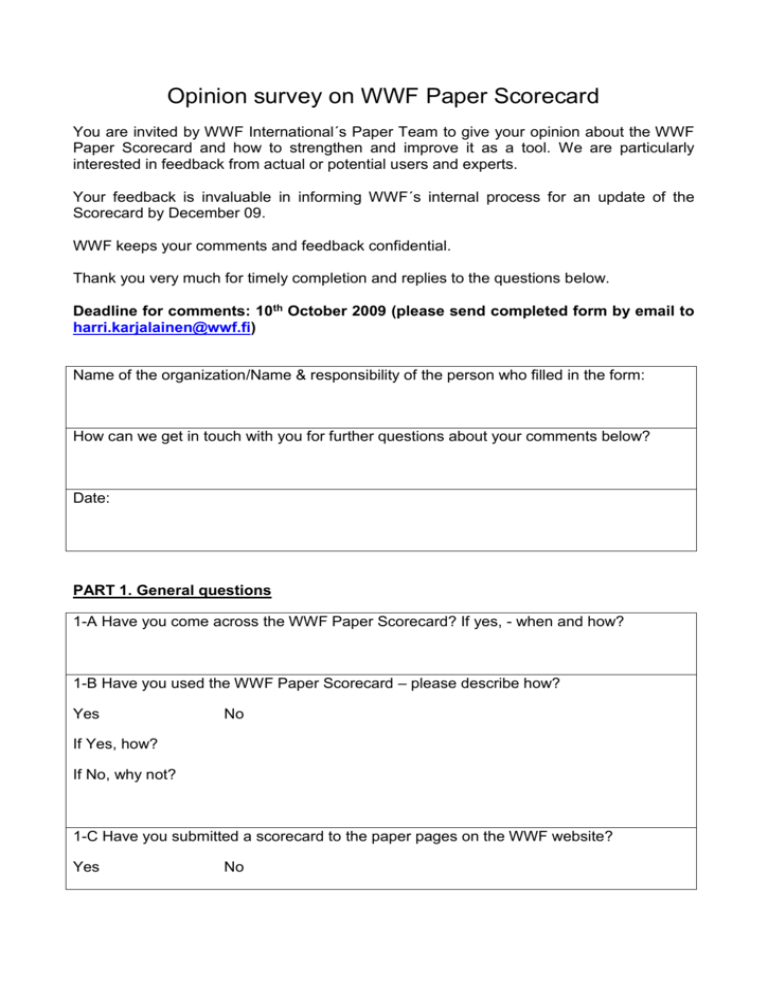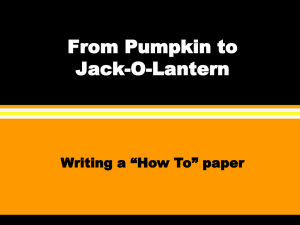Opinion survey on WWF Paper Scorecard You are invited by WWF
advertisement

Opinion survey on WWF Paper Scorecard You are invited by WWF International´s Paper Team to give your opinion about the WWF Paper Scorecard and how to strengthen and improve it as a tool. We are particularly interested in feedback from actual or potential users and experts. Your feedback is invaluable in informing WWF´s internal process for an update of the Scorecard by December 09. WWF keeps your comments and feedback confidential. Thank you very much for timely completion and replies to the questions below. Deadline for comments: 10th October 2009 (please send completed form by email to harri.karjalainen@wwf.fi) Name of the organization/Name & responsibility of the person who filled in the form: How can we get in touch with you for further questions about your comments below? Date: PART 1. General questions 1-A Have you come across the WWF Paper Scorecard? If yes, - when and how? 1-B Have you used the WWF Paper Scorecard – please describe how? Yes No If Yes, how? If No, why not? 1-C Have you submitted a scorecard to the paper pages on the WWF website? Yes No If No, why not? 1-D Please describe in general terms what you like about the WWF Paper Scorecard and why? What other systems/scorecards you use to rate the environmental performance of papers? 1-E What can WWF do to promote wider uptake and use of the WWF paper scorecard? 1-F What are in your view key challenges/opportunities for the use of WWF´s Paper Scorecard? Your ideas/views on how to overcome these challenges/make use of these opportunities? Challenges? Opportunities? PART 2 Questions related to Parameters, Definitions and Compliance and Verification Do you have specific suggestions for improvements relating to parameters, definitions and compliance and verification requirements in the Scorecard? Please be specific on why and how you could see these improved? 1. Preferred fibre sources 100% of fibres post-consumer recycled / FSC-certified virgin; or product FSC-labelled based on credit claims / FSC Recycled labelled: 20 p. Percent of fibres post-consumer recycled / FSC-certified virgin: > 95% > 90% > 85% > 80% > 75% 19 p. 18 p. 17 p. 16 p. 15 p. > 70% > 65% > 60% > 55% > 50% 14 p. 13 p. 12 p. 11 p. 10 p. > 45% > 40% > 35% > 30% > 25% 9 p. 8 p. 7 p. 6 p. 5 p. > 20% > 15% > 10% > 5% < 5% 4 p. 3 p. 2 p. 1 p. 0 p. Our score: 1.1 Definitions: This item refers to the total proportion of all fibres in the product / input to the mill that consist of, or corresponds through credit-based claims to: a) post consumer fibre material defined in accordance with FSC-STD-40-004; and/or b) virgin fibres from FSC-certified1 forests and plantations. Figures can be calculated either as the average annual proportional input to the product line / mill or as credit-based claims in accordance with FSC-STD- 40-004. 1.2 Compliance and Verification: Claims related to recycled materials should be verified by an internationally or nationally accredited certification body. Claims related to FSC-certified materials should be verified by an FSC-accredited certification body. 2-1-A Comment on Parameter: 2-1-B Comment on Definitions / Compliance and Verification: 2. Avoiding potential inclusion of unwanted fibre sources 100% of fibres post-consumer / pre-consumer recycled / FSC-certified virgin / FSC Controlled Wood or equivalent: 20 p. Percent of fibres post-consumer / pre-consumer recycled / FSC-certified virgin / FSC Controlled Wood or equivalent: > 95% > 90% > 85% > 80% > 75% 19 p. 18 p. 17 p. 16 p. 15 p. > 70% > 65% > 60% > 55% > 50% 14 p. 13 p. 12 p. 11 p. 10 p. > 45% > 40% > 35% > 30% > 25% 9 p. 8 p. 7 p. 6 p. 5 p. > 20% > 15% > 10% > 5% < 5% 4 p. 3 p. 2 p. 1 p. 0 p. Our score: 2.1 Definitions: This item refers to the proportion of fibre in the product that can be considered as safeguarded from the inclusion of materials from unwanted sources, including: illegally harvested wood; wood harvested in violation of traditional and civil rights; wood harvested in forests in which High Conservation Values are threatened by management activities; wood harvested in forests being converted from natural and semi natural forests to plantations or non-forest use; or wood harvested in stands where genetically modified trees have been planted. 2.2 Compliance and Verification: Fibre that falls within the following categories is considered as safeguarded from inclusion of unwanted fibre sources: a) post consumer fibre material as defined in FSC STD 40-004, verified by FSC accredited certification bodies, or through other systems of equal scope and rigour by internationally or nationally accredited certification bodies; b) pre-consumer fibre material as defined in FSC STD 40-004, verified by FSC-accredited certification bodies, or through other systems of equal scope and rigour by internationally or nationally accredited certification bodies;1 c) virgin fibre verified as originating from FSC certified forests and plantations by FSC-accredited certification bodies; d) virgin fibre verified as fulfilling all the requirements of the FSC Controlled Wood Standard FSC STD 40004, either as FSC Controlled Wood by FSC-accredited certification bodies, or through other systems of equal scope and rigour by internationally or nationally accredited certification bodies. 2-2-A Comment on Parameter: 2-2-B Comment on Definitions / Compliance and Verification: 3. Fossil CO2 emissions (electricity from grid/external sources included) Zero pulp and paper emissions of fossil CO2 20 pt Total pulp and paper emissions of fossil CO2 / T of paper: < 50 Kg 19 p. < 100 Kg 18 p. < 150 Kg 17 p. < 200 Kg 16 p. < 250 Kg 15 p. < 300 Kg 14 p. < 350 Kg 13 p. < 400 Kg 12 p. < 450 Kg 11 p. < 500 Kg 10 p. < 550 Kg 9 p. < 600 Kg 8 p. < 650 Kg 7 p. < 700 Kg 6 p. < 750 Kg 5 p. < 800 Kg < 850 Kg < 900 Kg < 950 Kg > 950 Kg 4 p. 3 p. 2 p. 1 p. 0 p. Our score: 3.1 Definitions: This item refers to the total amount of fossil CO2 emitted during the generation of the energy consumed in all industrial processes necessary to manufacture the product (including fossil CO2 emitted during the production of energy in power plants procured from the grid etc, but excluding fossil CO2 emitted as part of forest management or harvesting, as part of the production of coatings and fillers, or during transportation of raw-materials or finished products). Fossil CO2 is defined as carbon dioxide originating from materials that are non-renewable in human timescales (coal, oil, natural gas, peat and similar). 3.2 Compliance and Verification: The emission of fossil CO2 from each source is calculated based on the proportional contribution of various types of fossil fuels combusted in the generation of energy consumed in the production process, regardless of whether the energy is generated at the production site or in a power plant and distributed through the grid. 1 WWF acknowledges that several schemes have made contributions to improving forest management, but currently considers FSC certification as the system that best meets WWF’s basic requirements of responsibility, transparency, international consistency and balanced multi-stakeholder governance. 2 Certification and verification organisations that are audited against internationally recognised accreditation standards by nationally or internationally recognised accreditation bodies, e.g. members of the International Accreditation Forum. Calculation of CO2 emissions for each type of fossil fuel should be based on consistent, internationally acknowledged emission factors and methodology, e.g. in accordance with EU Guidelines. National averages should be used for calculations of emissions related to generation of grid electricity in the absence of mill specific data. Production of surplus energy for the grid from renewable sources (e.g. from biomass burnt at the pulp mill), as well as ‘green’ electricity from the grid representing energy production from renewable sources, may be used to offset CO2 emissions from equal amounts of fossil fuel-based energy procured from the grid (e.g. by the paper mill) when calculating the scores. Offsets must be calculated at mill average basis, and may not be allocated to specific products. Claims should be verified by an internationally or nationally accredited certification body. 2-3-A Comment on Parameter: 2-3-B Comment on Definitions / Compliance and Verification: 4. AOX emissions Zero pulp and paper mill emissions of AOX (pulp and paper unbleached or TCF / PCF): 10 p. Total pulp and paper mill emissions of AOX / T of paper: < 0.015 Kg < 0.030 Kg < 0.045 Kg < 0.060 Kg 9 p. 8 p. 7 p. 6 p. < 0.075 Kg < 0.090 Kg < 0.105 Kg < 0.120 Kg 5 p. 4 p. 3 p. 2 p. < 0.135 Kg 1 p. > 0.135 Kg 0 p. Our score: 4.1 Definitions: This item refers to the total emissions of adsorbable organic halogens, measured as the total amount of chlorine bound to organic compounds in waste water. 4.2 Compliance and Verification: Monitoring and measurements should be conducted in conformance with internationally acknowledged best practice procedures such as ISO 9562 (1989) or similar by impartial and competent laboratories. Claims should be verified by an internationally or nationally accredited certification body. 2-4-A Comment on Parameter: 2-4-B Comment on Definitions / Compliance and Verification: 5. COD emissions Zero pulp and paper mill emissions of COD: 10 p. Total pulp and paper mill emissions of COD / T of paper: < 2 Kg < 4 Kg < 6 Kg < 8 Kg 9 p. 8 p. 7 p. 6 p. < 10 Kg < 12 Kg < 14 Kg < 16 Kg 5 p. 4 p. 3 p. 2 p. < 18 Kg 1 p. > 18 Kg 0 p. Our score: 5.1 Definitions: This item refers to the total emissions to waste water of matter and compounds that consume oxygen during degradation, measured as the amount of oxygen needed for complete chemical oxidation. 5.2 Compliance and Verification: Monitoring and measurements should be conducted in conformance with internationally acknowledged best practice procedures such as ISO 6060 (1989) or similar by impartial and competent laboratories. Claims should be verified by an internationally or nationally accredited certification body. 2-5-A Comment on Parameter: 2-5-B Comment on Definitions / Compliance and Verification: 6. Waste to landfill Zero pulp and paper mill waste to landfill: 10 p. Total Total pulp and paper mill dry waste to landfill / T of paper: < 5 Kg < 10 Kg < 15 Kg < 20 Kg 9 p. 8 p. 7 p. 6 p. < 25 Kg < 30 Kg < 35 Kg < 40 Kg 5 p. 4 p. 3 p. 2 p. < 45 Kg 1 p. > 45 Kg 0 p. Our score: 6.1 Definitions: This item refers to non-hazardous waste materials from pulp and / or paper-making processes that are permanently disposed of as landfill / in dams at the site or elsewhere, expressed as the equivalent of bone dry matter. 6.2 Compliance and Verification: Monitoring and measurements should be conducted in conformance with internationally acknowledged best practice procedures. Claims should be verified by an internationally or nationally accredited certification body. 2-6-A Comment on Parameter: 2-6-B Comment on Definitions / Compliance and Verification: 7. Environmental Management Systems and Transparency All contributing pulp and paper mills are EMS certified and publicly report performance data annually 10 p. All contributing pulp and paper mills are EMS certified 8 p. Major contributing pulp and paper mills are EMS certified and publicly report performance data annually 6 p. Major contributing pulp and paper mills are EMS certified 4 p. Major contributing pulp or paper mills are EMS certified 2 p. Major contributing pulp or paper mills are not EMS certified 0 p. Our score: 7.1 Definitions: This item refers to: a) the proportions of the fibres in the final product that are processed in (pulp and / or paper) mills where all major relevant aspects of processing and production are addressed by environmental management systems that meet the requirements of ISO 14001, and b) the extent to which information on the environmental performance of mills is publicly reported. ‘Contributing’ refers to all (pulp and / or paper) mills that contribute fibres to the final product, ‘major’ refers to mills that process more than 50% of pulp fibre and paper fibre materials, respectively. ‘Performance data’ refers to, as a minimum, all the issues addressed in the WWF Paper Scorecard (the proportion of post consumer, pre-consumer and FSC-certified fibres and the proportion of fibres verified to meet the requirement of the FSC Controlled Wood standard; emissions of fossil CO2, AOX and COD per tonnes of finished paper product; dry waste to landfill per tonnes of finished product; and implementation of Environmental Management Systems). ‘Publicly’ refers to information in published Corporate Sustainability Reports and/or accessible through corporate websites. 7.2 Compliance and Verification: Implemented ISO 14001 Environmental Management Systems (or EMAS / other comparable environmental management systems) monitored and verified by an internationally or nationally accredited certification body. Transparency of performance data as per above verified by an internationally or nationally accredited certification body. 2-7-A Comment on Parameter: 2-7-B Comment on Definitions / Compliance and Verification: Many Thanks for your valuable feedback to WWF International!




